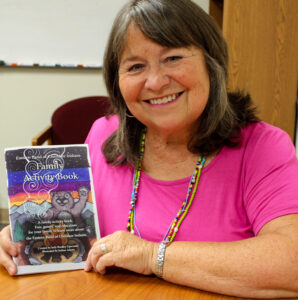By SCOTT MCKIE B.P.
ONE FEATHER STAFF
Families coming to Cherokee will now have the opportunity to further their education about the Eastern Band of Cherokee Indians (EBCI) thanks to a new book. Jody Bradley Lipscomb, an EBCI tribal member, has written the “Eastern Band of Cherokee Indians Family Activity Book” that is full of fun activities and valuable, correct information about the Tribe.
“We’ve been traveling a lot since I’ve been retired, and we would be places and I would see an activity book for kids, and I thought ‘we need one of those’,” Lipscomb said. “We need something that kids can get when they come to Cherokee that will be educational. That’s the teacher in me, wanting to educate people about things.”

Jody Bradley Lipscomb poses with her new book entitled “Eastern Band of Cherokee Indians Family Activity Book”. (SCOTT MCKIE B.P./One Feather photo)
As a youth, her first job was at the “Unto These Hills” outdoor drama. “We always got those crazy questions, ‘where’s the reservation?’ and ‘where do all the Indians live?’. So, I tried to address some of that in this book. And, I wanted it to be something that families could do together when they come, not just for kids.”
Lipscomb, who said she’s been working on the book project for close to five years, noted that a total of 100 books were in the first run that was printed at the Western Carolina University Print Shop. It is available locally at the Qualla Arts & Crafts Mutual, Inc. store or online at: https://authenticallycherokee.com/
The book was illustrated by Lipscomb’s son, noted Cherokee artist Joshua Adams. She thanks several people for their help in the project including: Joshua and Lauren Adams; Gene Lipscomb; Garfield Long who helped with the Cherokee language included in the book; Sherri Booth; Carmaleta Monteith; Bo Taylor, Museum of the Cherokee Indian executive director; Andrew Beck; Tom Frazier; and the staff of the WCU Print Shop.
“I wanted to make sure that there was some Cherokee language in there so that they could learn how to pronounce words,” Lipscomb commented. “So, I included phonetically how to say some of the words. I wanted them to learn how to write the Cherokee syllabary a little bit. I wanted them to know about some of the natural resources such as fish, turkeys, and elk.”
She also included places for visitors “not to miss” during their visit to Cherokee including the Museum of the Cherokee Indian, the Oconaluftee Indian Village, and others. “I wanted to make sure that we got them to places that were important along with the natural resources.”
Lipscomb hopes her book is well-received and utilized. “I really hope that it is educational so people will go back home and say ‘wow, we learned something new this trip’ or ‘we want to go back because we didn’t see this’. I just want people to learn more about Cherokee – learning the truth.”


